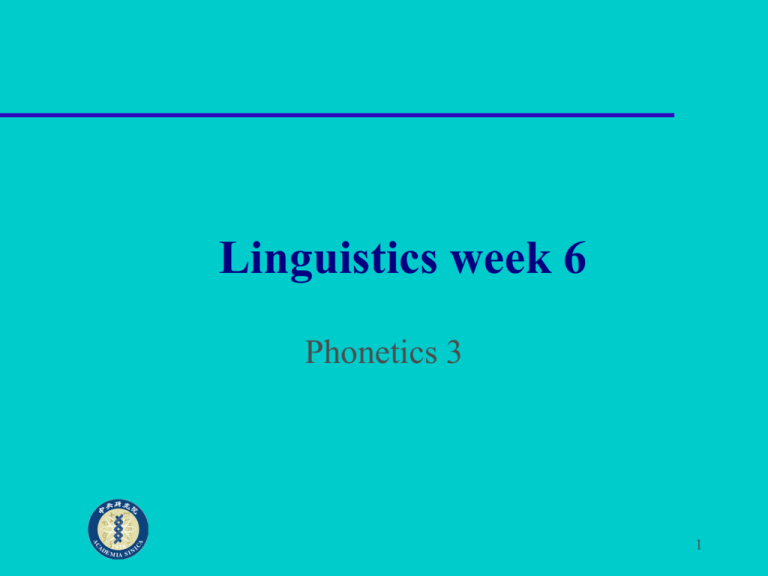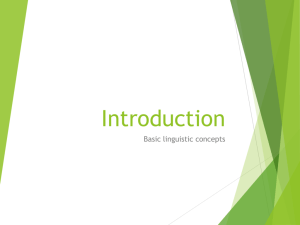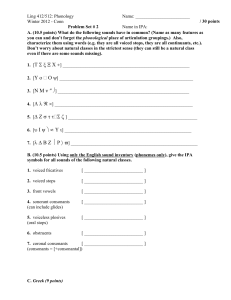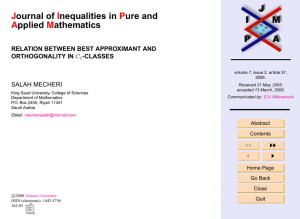Aspiration
advertisement

Linguistics week 6 Phonetics 3 1 Aspiration Aspirated and unaspirated consonants – – English: spit vs pit (aspiration difference) – – ㄅ is unaspirated [p] ㄆ is aspirated [ph] (puff of air) Compare pit vs bit That is a voicing difference Aspiration is much less important in English than in Chinese – Can you explain why? 2 Mandarin sounds (not yet) http://www.wfu.edu/~moran/Cathay_Cafe/I PA_NPA_4.htm 3 How many words, morphemes, syllables, consonants and vowels in the following? Count semivowels as consonants. 1. 2. 3. 4. 5. 6. 7. 8. 9. 10. Greenhouse Red houses Women 我們 Those sheep 老鼠 老太太 玻璃 John drinks coffee 他不喝咖啡 4 Syllable patterns (actually this is part of Phonology) With few exceptions, all syllables have exactly one vowel (V) In Mandarin, there exist 3 possible patterns – – – V CV CVC, where the last C must be [n] or [ŋ] English is more flexible – CCCVCCCC is possible, but still only one vowel 5 Check table 6.2, p243 6 Parameters for describing consonants So far (this is not complete yet) we have – – – – Airstream (usually the same for all consonants) Place of articulation Voicing Manner of articulation So, [p] is … – – – – egressive pulmonic bilabial voiceless plosive 7 Homework: consonants For all the plosives, nasals and fricatives that exist in English – – Learn the IPA and Fromkin phonetic symbols Learn how to describe each one in terms of the four parameters, like we just did for [p] 8 9 Clarification re [ʃ] and [ʒ] Fromkin says these sounds are palatal – also known as alveopalatal The IPA chart says they are postalveolar In the class (including today’s quiz) any of these will be OK – Aathough actually I don’t like the use of palatal here! 10 Clarification 2 Sounds like [t,d,n] are normally alveolar But they can be dental or postalveolar – It depnds on the speaker, and the shape of their mouth. 11 12 More manners of articulation: Trills (articulators collide rapidly and repeatedly) – – – Bilabial (brrr: not really part of English) [ʙ] Alveolar (perro dog, in Spanish) [r] Uvular (Paris, in French) [ʀ] Tap (usually alveolar) – – Like a trill, but only one collision In Spanish pero but [ɾ] 13 And glottal consonants… The glottal stop [ʔ] – – – – Usually without plosion Used in Cantonese 識唔識, 得唔得 Taiwanese? And English, in London accent! The glottal fricative [h] is generally used to represent English “h”, and ㄏ spoken by Taiwanese – In mainland Mandarin, it’s [x], a velar fricative 14 15 Some other fricative sounds Mandarin has a voiceless retroflex fricative – – There is also a voiced retroflex fricative – – – It is [ʂ], representing ㄕ Retroflexion means that the tongue is curled [ʐ], aka ㄖ However, some people transcribe this as [ɻ] They believe it is a retroflex approximant And, there is a voiceless alveolo-palatal fricative – [ɕ], or ㄒ (only the consonantal part) 16 Affricates A plosive followed by a homorganic fricative – – – – Homorganic = “same place of articulation” so [kf] in breakfast is not an affricate, because [k] and [f] do not have the same place of artic. [ʣ] and [ʦ] are affricates, but are not normally treated so in English phonology The only affricate English phonemes are /ʤ/ and /ʧ/ 17 Affricates in Mandarin /tsʰ/ and /ts/ /tʂʰ/ and /tʂ/ /tɕʰ/ and /tɕ/ – – – Can you guess what they are? What is the ʰ? Why have I suddenly started using /asd/ instead of [asd]? (slant brackets instead of square brackets) ㄘ and ㄗ ㄔ and ㄓ(retroflex affricate) ㄐ and ㄑ(alveolo-palatal affricate) 18 19 IPA: approximants (all voiced) An approximant – – 2 common realizations of /r/ (in addition to the trills described earlier) – – occurs as a consonant in syllabic patterning (CVC) but, it’s like a vowel, because the articulators usually don’t touch. [ɻ] retroflex approximant of Mandarin [ɹ] alveolar approximant of English A palatal approximant [j], often corresponding to the English spelling “y” A labial (=with rounded lips) velar approximant [w] Then there is lateral approximant [l] – Lateral = “side”, that is where the obstruction is 20 Glides and liquids in Fromkin The treatment of approximants in Fromkin is different – – You can read about it yourself on pp 249-50 Or you can just use the IPA treatment 21 This week Sound description, recording and animation. Take a look at http://www.uiowa.edu/~acadtech/phonetics/ about.html# and click on “English library”. Read about vowels, pp252-256. What are the parameters for describing vowels (like voicing, airstream etc with consonants)? 22







